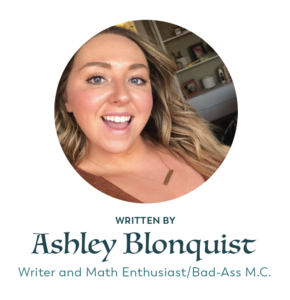Writing content like blog posts, articles, and Instagram captions is one thing. But writing your website content? A totally different playing field.
Maybe you have a vision of what your website will look like. And hey, you may also know what you want it to sound like. So…how do you bring it all to life?
Before you dive in, we need to tell you that your website doesn’t have to be perfect right off the bat. But you have to start somewhere, right?
Well, dear reader, that somewhere is here. Here’s how to write your website content in just 10 steps.
1. Define the purpose of your website
First thing’s first, you need to figure out the purpose of your website. Is it to grow your brand awareness? Attract new clients? Sell your products? Whatever your end goal, you’ll want to define it first, so you have guidance throughout the entire writing process.
Don’t put too much pressure on this initial step, though! Remember: The purpose of your website should adapt, grow, and change alongside your goals.
2. Understand your audience
Once you define your website’s purpose, it’s time to determine who you’re talking to. You can’t just throw words out into the digital sphere – you need to speak directly to your target audience(s). In addition to basic demographic information, you also need to ensure you understand things like their:
- Interests
- Dislikes
- Buying habits
- Digital preferences
- Educational backgrounds
- Pain points + hurdles
And – most importantly – you need to understand what problems you can help them solve.
3. Determine your brand proposition
Next up: It’s time to figure out what sets you apart from competing brands and websites – also called your brand proposition. You know what problems you can help your audiences solve, but chances are, others can help solve them, too. We don’t mean this to be discouraging; it’s just the reality of the entrepreneurial and small biz world.
So, what is it about your brand, products, services that set you apart from someone else’s? Is it your unique brand personality? Your processes? Whatever that unique selling point is, you’ll want to root it in your website content.
4. Choose your website pages
Now is where your website can start to take form. During this phase, you’ll want to determine what pages you want for your website. Depending on the purpose of your website – and what it is you’re selling – your pages might come to life in different ways. Typically, we suggest starting with at least these pages:
- Homepage
- About page
- Services or Products page
- Contact page
Once you have your pages figured out, you need to determine a purpose and goal for every single one of those pages. This will help keep you on track when you actually start to write your website content. Speaking of…
5. Write your content
Look at that! It’s finally time to write. (If you haven’t figured it out by now, writing website content requires so much more than shitting out words on a blank page.) To avoid becoming overwhelmed, write your content page by page. Along the way, make sure you:
- Stay clear and concise
- Speak directly to your audience
- Sound natural and personable
- Avoid using jargon or other terms your audience may not understand
- Keep paragraphs short and readable
- Always remember your purpose and goals
If you’re freezing up because you don’t know what to say, start by outlining what’s most important. On your Home page, for example, you’ll want to have a tagline or a quick line about what you do, a section for your services or products, a section that links to your About page, and a section with a call-to-action. You can easily “bullet” these out in an outline before you start writing and add notes to each section as you go. This makes it so much easier to start writing. Here’s an example of a site outline we did for our 2022 Waves of Change Grant winner!
6. Include keywords in your copy
Once you’ve written a rough draft of your website copy, it’s time to make it work harder for you. In other words: We want to make sure people actually see it. That’s where keywords come in.
Do some basic keyword research for each page on your website using the autofill feature on Google or tools like Moz Keyword Explorer, WordStream, or Google Search Console. From there, go back through your content and add keywords and phrases. Full stop: Keep it as natural as possible. Keyword stuffing isn’t cute (or effective).
Keywords are a part of a larger SEO strategy, which you can always enhance later. But for the sake of your website copy, there are several other optimizations you can make during the writing process that will help along the way, like:
- Adding headers throughout the page (H1s, H2s, H3s, etc.)
- Using bullet points and lists where you can
- Linking to other pages on your site (or credible outside sources)
- Adding alt text to images, infographics, and GIFs
Once you’re ready to go all-in on SEO, you can check out our content guide!
7. Don’t forget CTAs
Calls-to-action – also called CTAs – are a crucial part of any website that you can’t (and shouldn’t) overlook. A call-to-action is exactly that: It calls your audience(s) to take some sort of action. They should also match the goal and purpose of your page. That might look like:
- Learning more about your products or services
- Downloading a freebie
- Scheduling a call
- Signing up for your email newsletters
- Contacting you
- Buying something
- Watching a video
- Reading a blog
Whatever your CTAs are, make sure they’re explicitly clear. Don’t be unoriginal and use language like ‘Learn More’ or ‘Click Here.’ Actually, don’t ever use the latter. It’s against the law.
Also, make sure you’re using CTAs throughout your copy – not just in one place. You don’t want to make your audience go all the way to the bottom of a page before they can take any action. Or, you don’t want them to have to scroll all the way back up to take action. Find a happy medium!
8. Proofread and make edits
Before you hit publish, you’ll want to read your copy, then read it again, and make any necessary edits. Use a tool like Grammarly to check for misspellings, repetitive words and phrases, and anything else that doesn’t quite work.
Another one of our favorite editing tips? Read your content out loud. Hearing it vs. seeing it will make a hella big difference. Because if it doesn’t sound natural to you, it probably won’t sound natural to those reading it.
9. Schedule quarterly reviews and updates
Publishing your website is a huge accomplishment, and you should be really proud of yourself for that. BUT, (and this is a big but(t)), your website should never be a set-it-and-forget-it thing. Good websites are always up-to-date, relevant, and fresh AF.
So, instead of putting your site on the back burner, schedule time in the future to come back to it. We suggest adding quarterly reviews to your calendar, so you already have time set aside for any edits or additions. And hey, you have a review checklist now, too!
10. Hire a copywriter
If writing website content isn’t really your thing, that’s totally okay. Because it’s most definitely someone else’s thing (like, ahem, ours). And if you have other priorities and shit to do, you might just need a little help. Our suggestion? Hiring a copywriter.
By finding someone with writing experience, you can feel a lot more confident in your website content. So, whether you need a full-blown content strategy or just our referral list of copywriters, reach out to us and we can help your website come to life!

